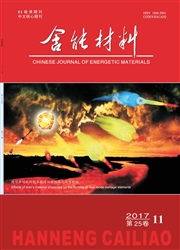

 中文摘要:
中文摘要:
针对半导体桥小型化带来的点火可靠性问题,制备了复合半导体桥,采用高速存贮示波器对其在22μF电容不同充电电压下的电爆过程进行了研究,并与多晶硅半导体桥的电爆性能进行了对比。结果显示:在电爆过程爆发前,复合半导体桥和多晶硅半导体桥的电爆过程基本一致;爆发后特别是在高压时(50 V),与多晶硅半导体桥相比,复合半导体桥上电流下降缓慢,爆发所需时间稍偏长,作用于等离子体上的能量稍多;爆发后3μs内,复合半导体桥作用于等离子体上的能量增加较多,因此复合半导体桥点火可靠性更高。复合半导体桥上金属薄膜的存在是造成上述结果差异的原因。
 英文摘要:
英文摘要:
For the ignition reliability of the semiconductor bridge miniaturization, the electrical explosive process of composite sem- iconductor bridge (SCB) with different charging voltages under 22 p,F were studied by high-speed digital oscilloscope. The electri- cal explosive performance of compositeSCB was compared with that ofpolycrystalline silicon SCB. Results show that before erup- ting, the electrical explosive process of composite SCB is in accordance with that of polycrystalline silicon SCB basically~ and after erupting, especially at the high voltage, the current of composite SCB decreases, and is lower than that of polycrystalline silicon SCB. The time of the erupting of compositeSCB is longer than that slightly. The energy acted on the plasma of composite SCB isa little larger than that of polycrystalline silicon SCB, and the energy acted on the plasma of compound SCB increases more than that of polycrystalline silicon SCB in 3 p,s after erupting, so the ignition reliability of composite SCB is better than that of compsite SCB. The primary cause, which results in the differences above, is the metallic film on comuosite SCB.
 同期刊论文项目
同期刊论文项目
 同项目期刊论文
同项目期刊论文
 期刊信息
期刊信息
